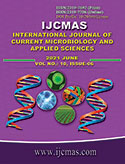


 National Academy of Agricultural Sciences (NAAS)
National Academy of Agricultural Sciences (NAAS)

|
PRINT ISSN : 2319-7692
Online ISSN : 2319-7706 Issues : 12 per year Publisher : Excellent Publishers Email : editorijcmas@gmail.com / submit@ijcmas.com Editor-in-chief: Dr.M.Prakash Index Copernicus ICV 2018: 95.39 NAAS RATING 2020: 5.38 |
Field pea is a legume most commonly consumed all over the world and is very popular in the vegetarian diets because of high levels of amino acids, lysine and tryptophan presence in it as compared to cereals. A field experiment was carried out in Inceptisols of Midland AICRPDA, during rabi 2020-21 in Instructional cum Research Farm, S.G. College of Agriculture and Research Station, I.G.K.V., Kumhrawand, Jagdalpur, Chhattisgarh, India lies at 19 °5'17.79"N latitude and 81°57'44.99"E longitude with an altitude of 552 meters above mean sea level. The experiment consists of five treatments viz., 20 days dry spell at 40 days after sowing, at flower initiation, after 50% flowering, Irrigation at 20 % soil moisture and control (Three irrigation) were laid out in Randomized Complete Block Design (RCBD) with four replications during rabi season of 2020-21. The higher plant height (54.27 cm), leaf area index (5.16), crop growth rate (0.400), days to flower (46.00), number of tendril (41.45) and root volume (6.208 v/v at 60 DAS) were observed with irrigation at 20% soil moisture being at par to 20 days dry spell after 50% flowering (54.12, 5.93, 0.378, 45.9, 41.15 and 6.175). The higher chlorophyll a and b were noticed under control (0.724 and 0.234) and found on par with irrigation at 20% soil moisture (0.678 and 0.132) during dry spell. The higher root volume was observed under the treatment where irrigation 20% soil moisture was done. The maximum branches was with 20 days dry spell after 50% flowering (4.5 and 52.2), whereas, more number of pods recorded (8.80) and seeds per pod (4.65) were recorded under control. Nitrogen uptake was significantly superior under control (70.21 kg ha-1), phosphorus (7.58 and kg ha-1) and potash (23.80 kg ha-1) were also noticed with control followed by irrigation at 20% soil moisture. The maximum grain yield (16.19 q ha-1) was recorded with control (three irrigations) and found significantly superior as compared to other treatments except the two treatments viz., 20 days dry spell after 50% flowering (16.03 q ha-1) and irrigation at 20% soil moisture (16.04 q ha-1), which were statistically similar to control (three irrigations). The highest B:C ratio was recorded with control (2.01), being significantly superior and comparable to both 20 days dry spell after 50% flowering (1.93) and irrigation at 20% soil moisture (1.89).
 |
 |
 |
 |
 |